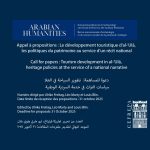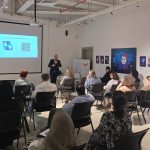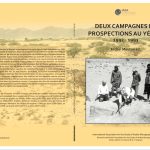AXIS III
Axis III
Spaces and Mobilities in the Arabian Peninsula.
Based on the social sciences (history, geography, sociology, anthropology, political science), this axis aims to explore the different forms of composition and recomposition of the space of the Arabian Peninsula in contemporary times. The relationship to space and its representation is considered in its human dimensions (migrations, demography), economic (development of cities, oil and post-oil issues) as well as socio-political (constructions of identities, cosmopolitical cultures social models) and artistic (architecture, visual arts, history of contemporary art).
In order to grasp both the local and global issues of the organization of space and its contemporary representation in the Gulf context, this research focuses, among other things, on the modes of urbanization and territorial transformations by questioning the way in which reveal changes in space that are not only material and physical, but also social and symbolic. Through prisms as original as they are varied, such as artistic practices, individual and collective subjectivities, social mobility or urban planning and architecture, the research dedicated to these themes aims to draw lines of thought leading to understanding what characterizes these themes in particularly divided and multicultural contexts. Rural/urban transformation, identity processes, but also the appropriation of space, both public and private, by the various inhabitants of the Arabian Peninsula, are thus at the center of the thinking of researchers whose work falls under Axis III.
1. The transformations of space in the Arabian Peninsula: from cities of incense to cities of the future
Although they have a past that has its roots in eras dating back to the medieval period and sometimes to antiquity, even prehistory, most cities of the Arabian Peninsula today are distinguished by the adoption of a development paradigm of neoliberal inspiration, open to the outside and resolutely turned towards the future. The coexistence of old urban models and ultra-modern plans is what strikes the observer of the urban worlds that have been developing for a little over half a century, in connection in particular with the oil industry.
Once important stages in the caravan trade, maritime trade and pearl trade, Muscat, Doha, Abu Dhabi, Manama, Kuwait City, or inland towns such as the Qasim and Ahsa oases, have become cities whose economic and financial activities are structured by the hydrocarbon industry. This peculiarity of the Gulf countries has led, in parallel and because of the planetary challenges posed by environmental issues, to the implementation of investment plans oriented towards the diversification of the economy, thus making the energy transition a major challenge for the Middle East.
Post-oil plans are not new. The recipes put forward to remedy the effects of the oil counter-shock in the 1980s and 1990s are still those that occupy the members of the Organization of the Petroleum Exporting Countries (OPEC): the limitation of production by means of quotas in order to raising prices, the reduction of the role of the state and of public expenditure in the economy, the nationalization of the workforce (the national preference) and the privileged role granted to the private sector to diversify national economies.
These economic dimensions guide the development of urban worlds and their links with agrarian worlds and the space of the desert. Despite delays and the abandonment of several of Masdar’s most “renewable” measures at the gates of Abu Dhabi, the Neom project in northwestern Saudi Arabia is modelled on a high-tech and green energy bubble. Because it is combined with the burial of the Rentier state, the energy transition is everywhere more profound than a set of purely economic reforms; it shows to what extent the economic dynamics in the Arabian Peninsula are associated with the social, cultural and political reconfigurations that they generate at the national and regional scale.
Although they have a past that has its roots in eras dating back to the medieval period and sometimes to antiquity, even prehistory, most cities of the Arabian Peninsula today are distinguished by the adoption of a development paradigm of neoliberal inspiration, open to the outside and resolutely turned towards the future. The coexistence of old urban models and ultra-modern plans is what strikes the observer of the urban worlds that have been developing for a little over half a century, in connection in particular with the oil industry.
Once important stages in the caravan trade, maritime trade and pearl trade, Muscat, Doha, Abu Dhabi, Manama, Kuwait City, or inland towns such as the Qasim and Ahsa oases, have become cities whose economic and financial activities are structured by the hydrocarbon industry. This peculiarity of the Gulf countries has led, in parallel and because of the planetary challenges posed by environmental issues, to the implementation of investment plans oriented towards the diversification of the economy, thus making the energy transition a major challenge for the Middle East.
Post-oil plans are not new. The recipes put forward to remedy the effects of the oil counter-shock in the 1980s and 1990s are still those that occupy the members of the Organization of the Petroleum Exporting Countries (OPEC): the limitation of production by means of quotas in order to raising prices, the reduction of the role of the state and of public expenditure in the economy, the nationalization of the workforce (the national preference) and the privileged role granted to the private sector to diversify national economies.
These economic dimensions guide the development of urban worlds and their links with agrarian worlds and the space of the desert. Despite delays and the abandonment of several of Masdar’s most “renewable” measures at the gates of Abu Dhabi, the Neom project in northwestern Saudi Arabia is modelled on a high-tech and green energy bubble. Because it is combined with the burial of the Rentier state, the energy transition is everywhere more profound than a set of purely economic reforms; it shows to what extent the economic dynamics in the Arabian Peninsula are associated with the social, cultural and political reconfigurations that they generate at the national and regional scale.
2. Mobilities, migrations and cosmopolitanisms
Today, the Arabian Peninsula stands out as an international hub where men, women, goods, cultures and capital converge. Its rapid modernization in the 20th century accelerated the process of globalization and the circulation of models of society, economy or urban planning. The very rapid urban development promotes unprecedented demographic growth: Dubai, for example, had 1.5 million inhabitants in 1966. Today, 3 million people live in this “global city”, of which only 12% are Emiratis, the rest being immigrant workers.
The fact of migration and the cultural exchanges it facilitates make it necessary to reflect on the questions of cultural transfers, otherness and diversity in the global world. These exchanges are thus taken as revealing the tensions caused by the questioning or even the break-up of ways of life and representations, as well as explanatory elements of the evolution of peninsular societies towards an increasingly trans-nationality more marked. Attached to the exploration of urban changes by articulating them to mobility and migration, the research under this axis works to understand the mechanisms of construction of global cities, and more particularly, within world cities, it seeks to reflect on the concept of cosmopolitan cities and to grasp the empirical manifestations of cosmopolitanism through a multidisciplinary and comparative approach.
The research carried out at CEFREPA in this perspective inquires also the public policies that strongly determine the relationship to public space, the reconfigurations of gender relations, generational differentiations, in addition to local affiliations (sociolinguistic, ethnic, religious, etc.) in cosmopolitan contexts. Migration regimes and the constitution of identity communities marked by phenomena relating to globalization are also a priority area of investigation for this axis. Finally, it is a question of grasping the way in which subjectivities are constructed, through the shaping of daily spaces and of oneself, which are themselves highly particularized.
Beyond national or regional borders, the study of mobility makes it possible to grasp the socio-cultural mechanisms that connect the individual, society and space. This axis therefore helps to create a space for intellectual discussion on this theme which is still little known in France and which is nevertheless strongly debated in many countries (United States, Great Britain, Germany, Italy, Australia for example): cosmopolitanism as a specific analysis of living together and the functioning of social ties in global cities.
3. Urban modernity and visual arts
In recent years, some cities in the Arabian Peninsula have aspired to play a new role, that of becoming a leading artistic and tourist destination, and of playing the role of a cultural “hub”, a meeting place for artists from the region but also of the world. Initiated by Dubai, this process is reproduced in Qatar, Kuwait or Saudi Arabia, with the proliferation of museums, galleries, centers for the promotion of contemporary art, often in peripheral and industrial urban spaces, which has favored the creation of an artistic scene in the Gulf region and above all of an art market which is in full expansion. From Art Dubai, the contemporary art fair created in 2006, to the Universal Exhibition inaugurated in 2020, the field of visual arts indeed seems to want to contribute to changing not only the image of the city but the city itself.
While contemporary art has experienced unprecedented growth in the Arabian Peninsula for several years, the literature on the subject remains surprisingly insufficient. The development of large-scale museum parks in the United Arab Emirates and Qatar has helped draw the attention of researchers to the different dimensions – political, economic, geopolitical and social – of these projects. In contrast, the history of contemporary art throughout the region, the structuring and evolution of markets and artistic scenes, the multiplication of public institutions and private initiatives, just as current artistic practices and movements do not receive the same attention. However, in addition to the purely historical and documentary interest on this subject, contemporary art and the aesthetic conceptions that underlie it constitute a relevant entry point for understanding and analyzing the recent changes in this region.
This field of research thus aims to contribute to the writing of the history of contemporary art in the Arabian Peninsula, in particular in connection with the study of space and its cultural, aesthetic and symbolic representations, the aim being to propose theoretical and conceptual tools to approach it in all its complexity. Resolutely multidisciplinary, it brings together both researchers and professionals – notably artists, art critics and exhibition curators – from the worlds of contemporary art in the region.
Research devoted to the visual arts are also committed to describe the trajectories of artists and artistic practices while linking them to the political and historical context of the Arabian Peninsula, with the aim of questioning the relationship between the State, its institutions and the art worlds. In countries where state patronage is central to the emergence of artistic scenes, research in this sub-axis focuses particularly on the study of a country’s cultural policies, to question artists’ views on the state and the state’s hold over art.
In recent years, some cities in the Arabian Peninsula have aspired to play a new role, that of becoming a leading artistic and tourist destination, and of playing the role of a cultural “hub”, a meeting place for artists from the region but also of the world. Initiated by Dubai, this process is reproduced in Qatar, Kuwait or Saudi Arabia, with the proliferation of museums, galleries, centers for the promotion of contemporary art, often in peripheral and industrial urban spaces, which has favored the creation of an artistic scene in the Gulf region and above all of an art market which is in full expansion. From Art Dubai, the contemporary art fair created in 2006, to the Universal Exhibition inaugurated in 2020, the field of visual arts indeed seems to want to contribute to changing not only the image of the city but the city itself.
While contemporary art has experienced unprecedented growth in the Arabian Peninsula for several years, the literature on the subject remains surprisingly insufficient. The development of large-scale museum parks in the United Arab Emirates and Qatar has helped draw the attention of researchers to the different dimensions – political, economic, geopolitical and social – of these projects. In contrast, the history of contemporary art throughout the region, the structuring and evolution of markets and artistic scenes, the multiplication of public institutions and private initiatives, just as current artistic practices and movements do not receive the same attention. However, in addition to the purely historical and documentary interest on this subject, contemporary art and the aesthetic conceptions that underlie it constitute a relevant entry point for understanding and analyzing the recent changes in this region.
This field of research thus aims to contribute to the writing of the history of contemporary art in the Arabian Peninsula, in particular in connection with the study of space and its cultural, aesthetic and symbolic representations, the aim being to propose theoretical and conceptual tools to approach it in all its complexity. Resolutely multidisciplinary, it brings together both researchers and professionals – notably artists, art critics and exhibition curators – from the worlds of contemporary art in the region.
Research devoted to the visual arts are also committed to describe the trajectories of artists and artistic practices while linking them to the political and historical context of the Arabian Peninsula, with the aim of questioning the relationship between the State, its institutions and the art worlds. In countries where state patronage is central to the emergence of artistic scenes, research in this sub-axis focuses particularly on the study of a country’s cultural policies, to question artists’ views on the state and the state’s hold over art.










